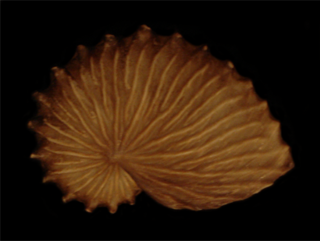Related Research Articles

The argonauts are a group of pelagic octopuses. They are also called paper nautili, referring to the paper-thin eggcase that females secrete. This structure lacks the gas-filled chambers present in chambered nautilus shells and is not a true cephalopod shell, but rather an evolutionary innovation unique to the genus. It is used as a brood chamber, and to trap surface air to maintain buoyancy. It was once speculated that argonauts did not manufacture their eggcases but utilized shells abandoned by other organisms, in the manner of hermit crabs. Experiments by pioneering marine biologist Jeanne Villepreux-Power in the early 19th century disproved this hypothesis, as Villepreux-Power successfully reared argonaut young and observed their shells' development.

Argonauta argo, also known as the greater argonaut, is a species of pelagic octopus belonging to the genus Argonauta. The Chinese name for this species translates as "white sea-horse's nest".

Argonauta nouryi, also known as Noury's argonaut, is a species of pelagic octopus. The female of the species, like all argonauts, creates a paper-thin eggcase that coils around the octopus much like the way a nautilus lives in its shell. The shell is usually approximately 80 mm in length, although it can exceed 90 mm in exceptional specimens; the world record size is 95.5 mm.

Argonauta hians, also known as the winged argonaut, muddy argonaut or brown paper nautilus, is a species of pelagic octopus. The common name comes from the grey to brown coloured shell. The Chinese name for this species translates as "Grey Sea-horse's Nest". The female of the species, like all argonauts, creates a paper-thin eggcase that coils around the octopus much like the way a nautilus lives in its shell. The eggcase is characterised by a wide keel that gives it a square appearance, few rounded tubercles along the keel, and less than 40 smooth ribs across the sides of the shell. The shell is usually approximately 80 mm in length, although it can exceed 120 mm in exceptional specimens; the world record size is 121.5 mm.

Argonauta bottgeri, also known as Böttger's argonaut, is a species of pelagic octopus belonging to the genus Argonauta. The female of the species, like all argonauts, creates a paper-thin eggcase that coils around the octopus much like the way a nautilus lives in its shell.
Argonauta tokunagai is an extinct species of octopus. It was described in 1913 based on fossil material from the Middle Miocene Huzina Formation of Japan.
Aprominta aga is a moth of the family Autostichidae. It is found on the Aegean Islands and in Turkey.
Aprominta aperitta is a moth of the family Autostichidae. It is found on the Aegean Islands.
Aprominta atricanella is a moth of the family Autostichidae. It is found in Bulgaria, North Macedonia and Greece.
Aprominta bifasciata is a moth in the family Autostichidae. It is found in Greece and Turkey.
Aprominta cryptogamarum is a moth of the family Autostichidae. It is found in France, Italy and Spain.
Aprominta designatella is a moth of the family Autostichidae. It is found in Albania, Bosnia and Herzegovina, Croatia, Serbia, Bulgaria, Romania, North Macedonia, Greece, Russia and Turkey.
Aprominta gloriosa is a moth of the family Autostichidae. It is found in Greece.
Aprominta pannosella is a moth of the family Autostichidae. It is found in Greece.
Aprominta reisseri is a moth of the family Autostichidae. It is found on Crete.
Aprominta tectaphella is a moth of the family Autostichidae. It is found on Crete.
Aprominta separata is a moth of the family Autostichidae. It is found on Crete.
Aprominta xena is a moth of the family Autostichidae. It is found on Crete.

The Spanish ship Argonauta was a third-rate 80 gun ship of the line of the Spanish Navy. She had 24, 18 and 8 pounder guns spread over two decks. Her usual crew was 642, though it was 956 at the Battle of Cape Finisterre and 800 at Trafalgar.

Aprominta is a Palearctic moth genus in the family Autostichidae. One species Aprominta australis Gozmány, 1966 is Afrotropical.